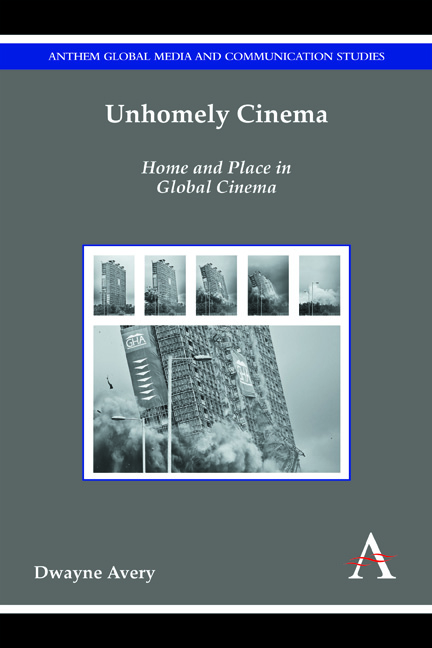Book contents
- Frontmatter
- Contents
- Introduction Unhomely Cinema
- Chapter 1 An Unhomely Theory
- Chapter 2 The Decline of the Family: Home and Nation in Krzysztof Kieślowski's The Decalogue
- Chapter 3 The Future Is behind You: Global Gentrification and the Unhomely Nature of Discarded Places
- Chapter 4 No Place to Call Home: Work and Home in Paul Thomas Anderson's Punch Drunk Love and Jason Reitman's Up in the Air
- Chapter 5 The Terrible Lightness of Being Mobile: Cell Phone and the Dislocation of Home
- Chapter 6 Unhomely Revolt in Laurent Cantet's Time Out
- Conclusion
- References
- INDEX
Chapter 1 - An Unhomely Theory
Published online by Cambridge University Press: 05 November 2014
- Frontmatter
- Contents
- Introduction Unhomely Cinema
- Chapter 1 An Unhomely Theory
- Chapter 2 The Decline of the Family: Home and Nation in Krzysztof Kieślowski's The Decalogue
- Chapter 3 The Future Is behind You: Global Gentrification and the Unhomely Nature of Discarded Places
- Chapter 4 No Place to Call Home: Work and Home in Paul Thomas Anderson's Punch Drunk Love and Jason Reitman's Up in the Air
- Chapter 5 The Terrible Lightness of Being Mobile: Cell Phone and the Dislocation of Home
- Chapter 6 Unhomely Revolt in Laurent Cantet's Time Out
- Conclusion
- References
- INDEX
Summary
The Uncanny '90s
In 1919, Freud published, “The Uncanny,” a brief essay that sheds light on the meaning of the uncanny by analysing the short stories of E. T. A. Hoffmann. In many ways, “The Uncanny” represents an odd work within Freud's impressive oeuvre. Though the essay focuses on Freud's new theory of psychoanalysis, especially the castration complex, it is hard not to read the essay as a cipher of the times, especially in light of important historical events, like the rise of modern industrial society or the horrors witnessed during the First Great War. This does not mean that the essay should be read exclusively as a cultural map of the times or a “historical allegory” of the surrounding political, social and technological environments (Castle 1995); nonetheless, Freud's exploration of everyday uncanniness, especially his fascination with contemporary technologies, like the robot-like automata featured in Hoffmann's story “The Sandman,” provides a succinct glimpse into some of the dramatic social and technological changes associated with the early twentieth century. Even more fascinating is that, while the essay represented a minor work during Freud's time, “The Uncanny” continues to resonate with, even haunt, the contemporary imaginary, as the essay has become a monumental source of inspiration for a wide range of social and cultural theorists, from the philosophical works of Jacques Derrida to the literary criticism of Terry Castle.
- Type
- Chapter
- Information
- Unhomely CinemaHome and Place in Global Cinema, pp. 9 - 28Publisher: Anthem PressPrint publication year: 2014



